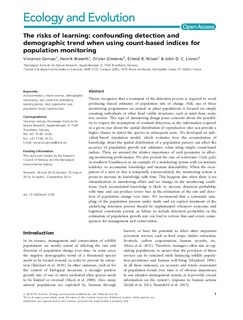| dc.description.abstract | Theory recognizes that a treatment of the detection process is required to avoid
producing biased estimates of population rate of change. Still, one of three
monitoring programmes on animal or plant populations is focused on simply
counting individuals or other fixed visible structures, such as natal dens, nests,
tree cavities. This type of monitoring design poses concerns about the possibility
to respect the assumption of constant detection, as the information acquired
in a given year about the spatial distribution of reproductive sites can provide a
higher chance to detect the species in subsequent years. We developed an individual-
based simulation model, which evaluates how the accumulation of
knowledge about the spatial distribution of a population process can affect the
accuracy of population growth rate estimates, when using simple count-based
indices. Then, we assessed the relative importance of each parameter in affecting
monitoring performance. We also present the case of wolverines (Gulo gulo)
in southern Scandinavia as an example of a monitoring system with an intrinsic
tendency to accumulate knowledge and increase detectability. When the occupation
of a nest or den is temporally autocorrelated, the monitoring system is
prone to increase its knowledge with time. This happens also when there is no
intensification in monitoring effort and no change in the monitoring conditions.
Such accumulated knowledge is likely to increase detection probability
with time and can produce severe bias in the estimation of the rate and direction
of population change over time. We recommend that a systematic sampling
of the population process under study and an explicit treatment of the
underlying detection process should be implemented whenever economic and
logistical constraints permit, as failure to include detection probability in the
estimation of population growth rate can lead to serious bias and severe consequences
for management and conservation.
Autocorrelation, citizen science, demographic
monitoring, den, detection probability,
learning period, nest, population size,
population trend, reproduction. | nb_NO |

